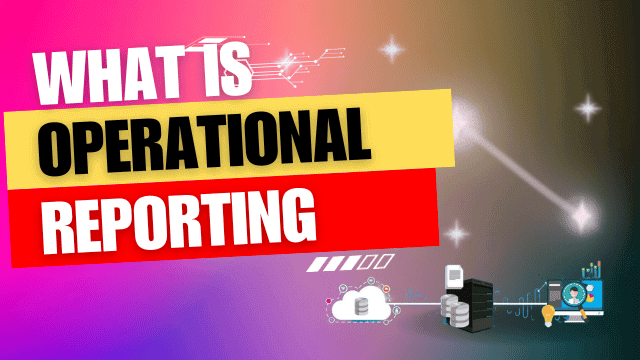Demystifying the Backbone of Efficient Business
Operational reporting might sound like a complex term, but let’s break it down into simpler, understandable chunks. Have you ever wondered how businesses keep track of their day-to-day operations? How they analyze their performance, make informed decisions, and ensure everything runs smoothly? Well, that’s where operational reporting comes into play. In this article, we’ll take you on a journey through the world of operational reporting, making it crystal clear, just like a polished diamond. So, grab your cup of coffee, and let’s dive in!
1. Understanding Operational Reporting
Operational reporting is the heartbeat of any organization. It’s like the dashboard of your car, providing real-time information about the engine’s performance. In the business world, operational reports offer insights into day-to-day activities, helping managers and decision-makers track progress and make informed choices.
2. Why is Operational Reporting Important?
Ever wondered how your favorite online store ensures they always have your favorite products in stock? Operational reporting is the magic wand that helps them do it. It enables businesses to monitor inventory, sales, customer feedback, and more. In essence, it’s the key to efficiency and customer satisfaction.
3. Components of Operational Reporting
Operational reports are made up of various components, such as data sources, data transformation, and data visualization. Think of it as assembling a puzzle; each piece (component) contributes to the big picture.
4. Types of Operational Reports
Operational reports come in different flavors, including performance reports, exception reports, and ad-hoc reports. They serve different purposes but share the common goal of keeping the ship sailing smoothly.
5. The Role of Technology
In today’s digital age, technology plays a crucial role in operational reporting. Software and tools make it easier to collect, process, and present data. It’s like having a supercharged magnifying glass to spot even the tiniest issues.
6. Benefits of Effective Operational Reporting
Effective operational reporting leads to improved decision-making, increased productivity, cost savings, and enhanced customer experiences. It’s like having a compass that guides you through the business wilderness.
7. Challenges in Operational Reporting
Like any journey, operational reporting has its challenges. Data accuracy, integration issues, and data overload can be hurdles. But with the right strategies, these challenges can be overcome.
8. Best Practices for Operational Reporting
To master the art of operational reporting, businesses should follow best practices, including defining clear objectives, selecting the right metrics, and ensuring data quality. It’s like following a recipe for a perfect dish.
9. Real-world Examples
Let’s take a look at how some well-known companies leverage operational reporting to stay ahead of the curve. From Amazon’s inventory management to Uber’s real-time ride tracking, these examples showcase the power of operational reporting.
10. Conclusion
In conclusion, operational reporting is the unsung hero that keeps businesses thriving. It simplifies complex data into actionable insights, driving success in today’s fast-paced world.
Frequently Asked Questions (FAQs)
Q1: What exactly is operational reporting?
Operational reporting is the process of collecting, processing, and presenting data related to day-to-day business activities. It helps organizations monitor performance and make informed decisions.
Q2: Why is operational reporting important for businesses?
Operational reporting is crucial for businesses as it enables them to track their operations, optimize processes, and ensure efficient use of resources. It leads to improved decision-making and enhanced customer satisfaction.
Q3: What are the common challenges in operational reporting?
Some common challenges in operational reporting include data accuracy, integration issues, and data overload. These challenges can be overcome with the right strategies and technology.
Q4: How does technology impact operational reporting?
Technology plays a significant role in operational reporting by simplifying data collection, analysis, and visualization. It enhances the speed and accuracy of reporting, leading to better insights.
Q5: Can you provide examples of companies using operational reporting?
Certainly! Amazon uses operational reporting to manage its vast inventory efficiently, while Uber relies on it for real-time ride tracking. These examples demonstrate the versatility of operational reporting in various industries.
In a world driven by data and efficiency, operational reporting is the lighthouse guiding businesses through the stormy seas of competition. It empowers them to navigate with confidence, make informed decisions, and ultimately, achieve success. So, embrace the power of operational reporting, and watch your business set sail toward new horizons!
Understanding Operational Reporting
Operational reporting is like the daily check-up for a business. It’s the tool that helps a company keep an eye on how things are going every day. Think of it as your morning routine of brushing your teeth, checking the weather, and making a to-do list. Businesses do something similar, but instead of teeth, they’re looking at sales, inventory, customer feedback, and more.
Why is this daily check-up important, you might wonder? Well, imagine if you ran your favorite online store. You’d want to make sure you always have the products your customers love, right? Operational reporting is the secret sauce behind this magic. It helps businesses keep track of what’s selling, what’s in stock, and how happy their customers are. In short, it’s all about making sure everything runs smoothly.
Now, let’s break it down a bit further. Operational reports are like the pieces of a puzzle. You know how each puzzle piece is a bit different, but when you put them all together, you get a complete picture? Operational reports work the same way. They’re made up of different parts, like where the data comes from, how it’s transformed into useful information, and how it’s shown on graphs and charts.
These reports come in different flavors too, kind of like different types of ice cream. You’ve got performance reports, which tell you how well things are going. Then there are exception reports, which shout out when something’s not quite right. And finally, there are ad-hoc reports, which are like custom reports for special occasions.
In the modern world, technology is the wizard behind the curtain of operational reporting. It’s like having a magic wand that makes everything easier. Software and tools help businesses gather, process, and show the data. Imagine having a supercharged magnifying glass that can spot even the tiniest problems in your business. That’s what technology does for operational reporting.
Now, why should anyone care about all this? Well, when operational reporting is done right, it leads to better decisions. It’s like having a compass to guide you through a dense forest. You can see where you are, where you’re going, and what obstacles might be in your way. It saves time, money, and keeps customers happy.
But, like any journey, there are challenges along the way. Sometimes the data isn’t quite right, or it doesn’t fit together well. Think of it like trying to build a puzzle with pieces from different sets; it can get messy. However, with the right strategies and tools, these challenges can be overcome.
To master the art of operational reporting, businesses follow best practices. It’s like following a recipe to make the perfect dish. They set clear goals, pick the right ingredients (or metrics), and make sure everything is of high quality.
Now, let’s see some real-world examples. Think of Amazon, the giant online store. They use operational reporting to keep track of millions of products in their warehouses. Or take Uber, the ride-sharing service. They rely on operational reporting to track drivers and passengers in real-time, making sure everyone gets where they need to go.
In the end, operational reporting is like the unsung hero in the background, making sure everything in a business runs smoothly. It’s like the engine of a car, quietly doing its job while you focus on driving. So, the next time you order something online or hop in an Uber, remember that operational reporting is the secret sauce making it all work seamlessly.
Importance of Operational Reporting
Operational reporting is like the compass that helps businesses navigate the vast sea of their daily operations. It’s the tool that keeps them on course, ensuring they reach their destination efficiently and safely.
But why is operational reporting so crucial?
Imagine you’re the captain of a ship. Your ship represents your business, and you’re sailing through the ever-changing waters of the market. To avoid storms, make the best use of favorable winds, and reach your destination on time (which, in this case, is your business goals), you need to know exactly where you are, where you’re heading, and what obstacles might be in your way. Operational reporting provides you with this critical information.
Here are a few reasons why operational reporting is a game-changer for businesses:
- Real-time Awareness: Operational reporting gives you a real-time view of what’s happening within your business. It’s like having a live map that shows your ship’s location, the weather conditions, and any nearby obstacles. With this information, you can adjust your course as needed, ensuring you stay on the right path.
- Data-Driven Decision Making: In today’s competitive business landscape, decisions need to be based on data, not gut feelings. Operational reporting provides you with data-driven insights. It’s like having a trusted advisor who provides you with all the facts and figures you need to make informed choices.
- Efficiency Boost: Just like a well-tuned ship sails faster and consumes less fuel, an efficiently managed business operates more smoothly and cost-effectively. Operational reporting helps you identify areas where you can optimize processes and reduce wastage.
- Customer Satisfaction: Happy customers are like a favorable wind that propels your ship forward. Operational reporting allows you to monitor customer feedback and satisfaction levels. If there’s a storm brewing in the form of unhappy customers, you can address it before it becomes a hurricane.
- Resource Allocation: Like managing the crew and supplies on a ship, businesses need to allocate resources wisely. Operational reporting helps you track resource usage, ensuring that you’re not running out of essential supplies or overloading your crew (employees).
- Spotting Red Flags: Just as you’d want to know if your ship is taking on water, operational reporting alerts you to any issues in your business. Whether it’s declining sales, inventory shortages, or quality problems, operational reports act as early warning signals.
In a nutshell, operational reporting is like the captain’s log of a business journey. It keeps a detailed record of everything that’s happening, allowing you to steer your ship towards success. Without it, you’d be sailing blindfolded, hoping for the best but likely encountering more obstacles and setbacks along the way.
So, if you want your business ship to sail smoothly, make the most of operational reporting. It’s the tool that ensures you not only survive but thrive in the unpredictable seas of the business world.


